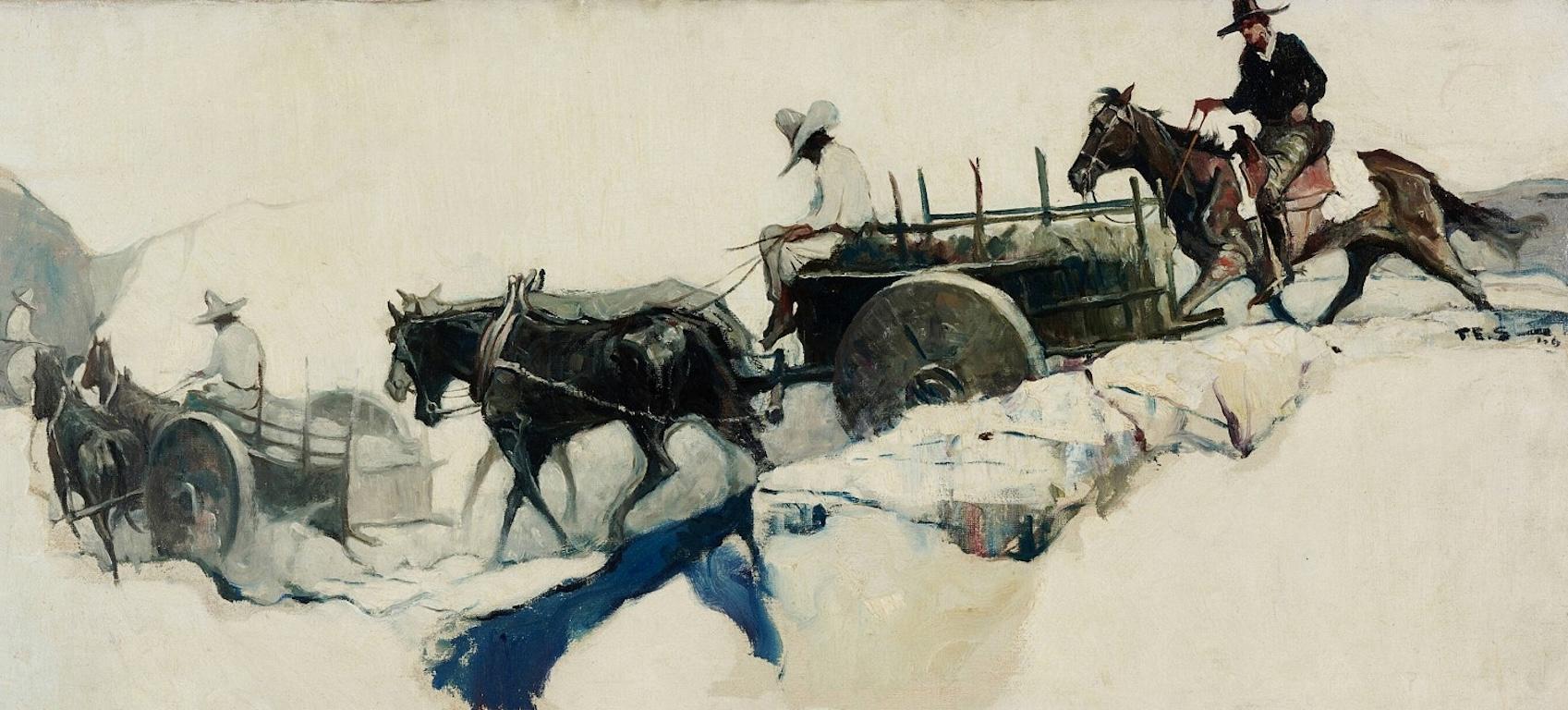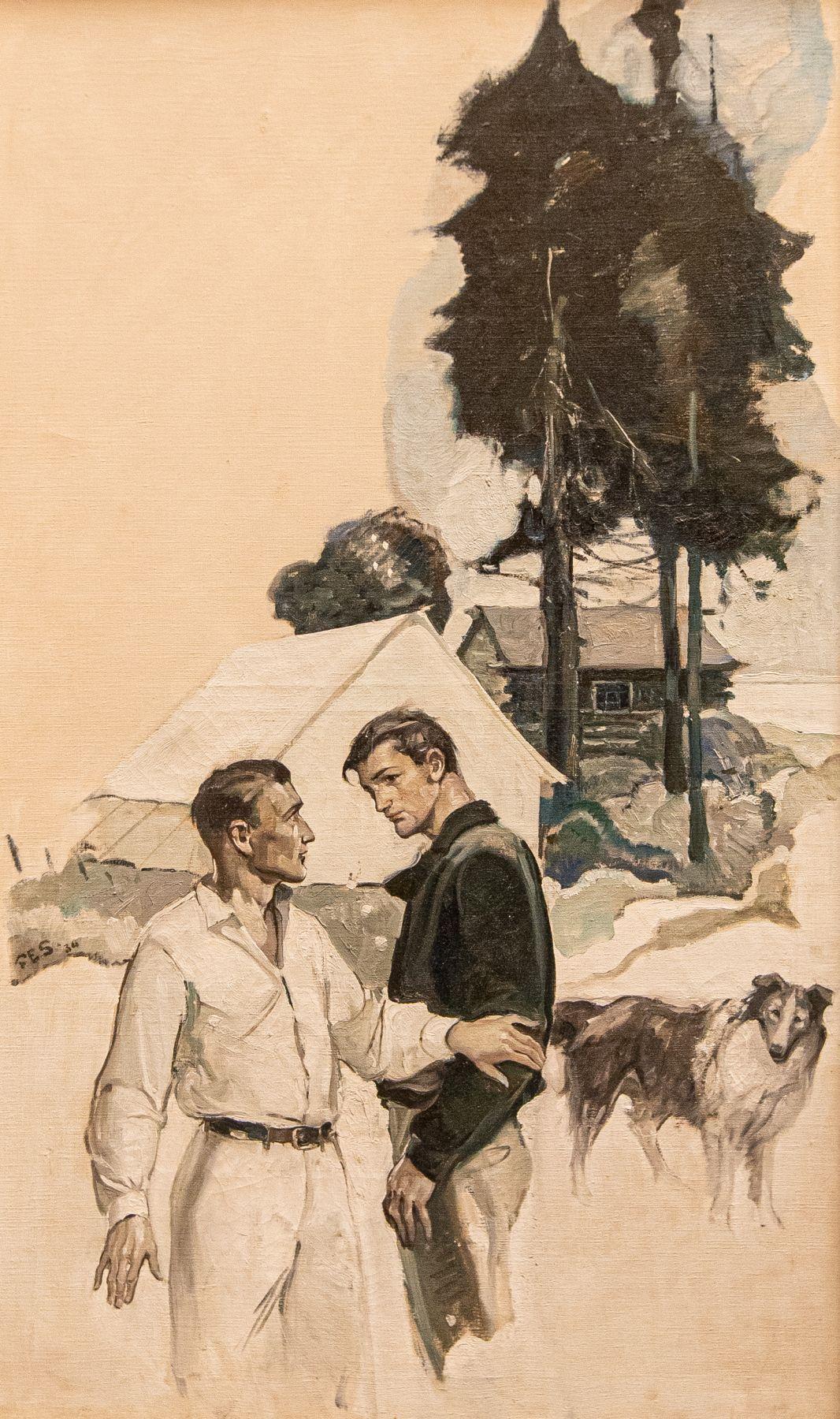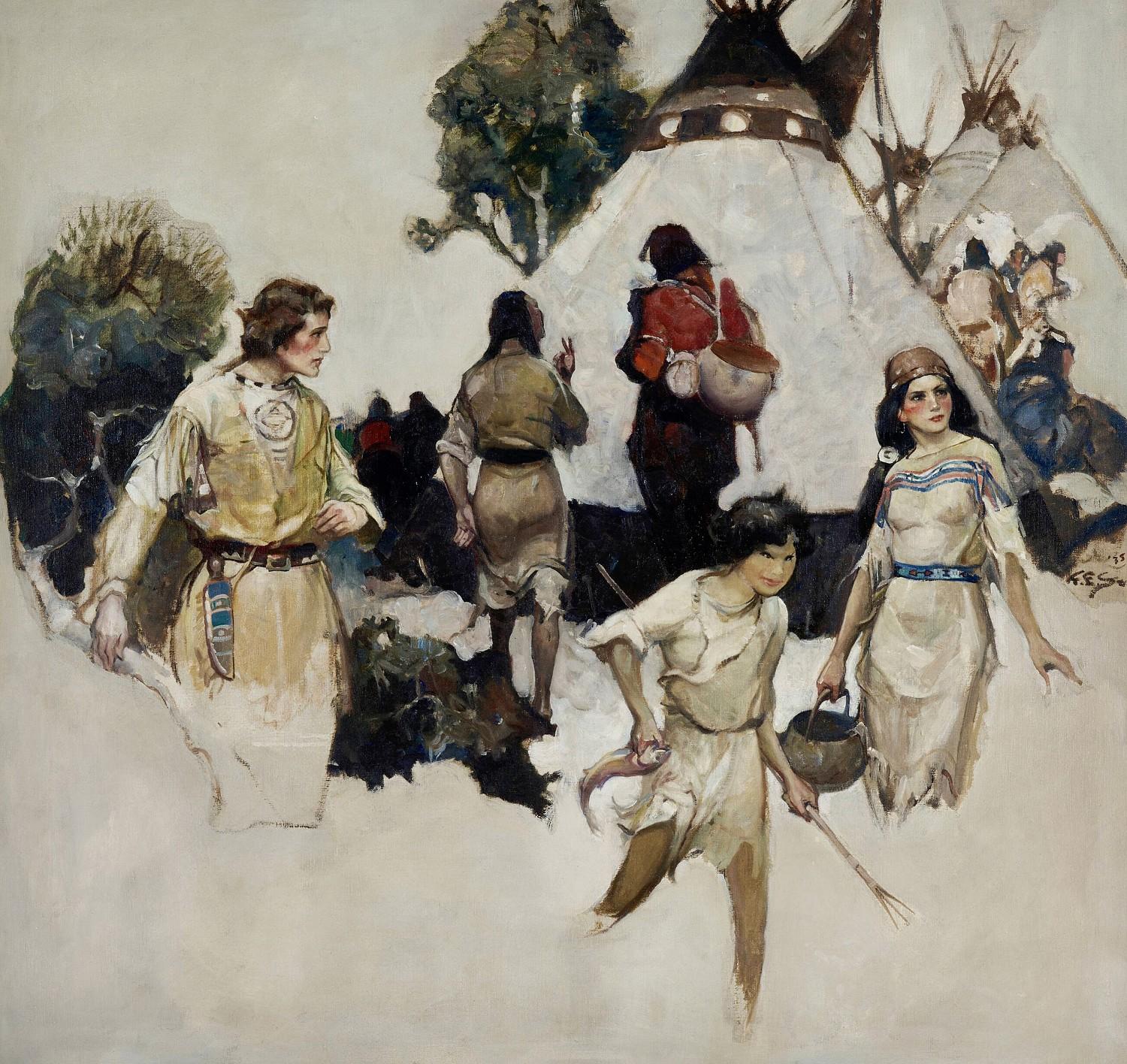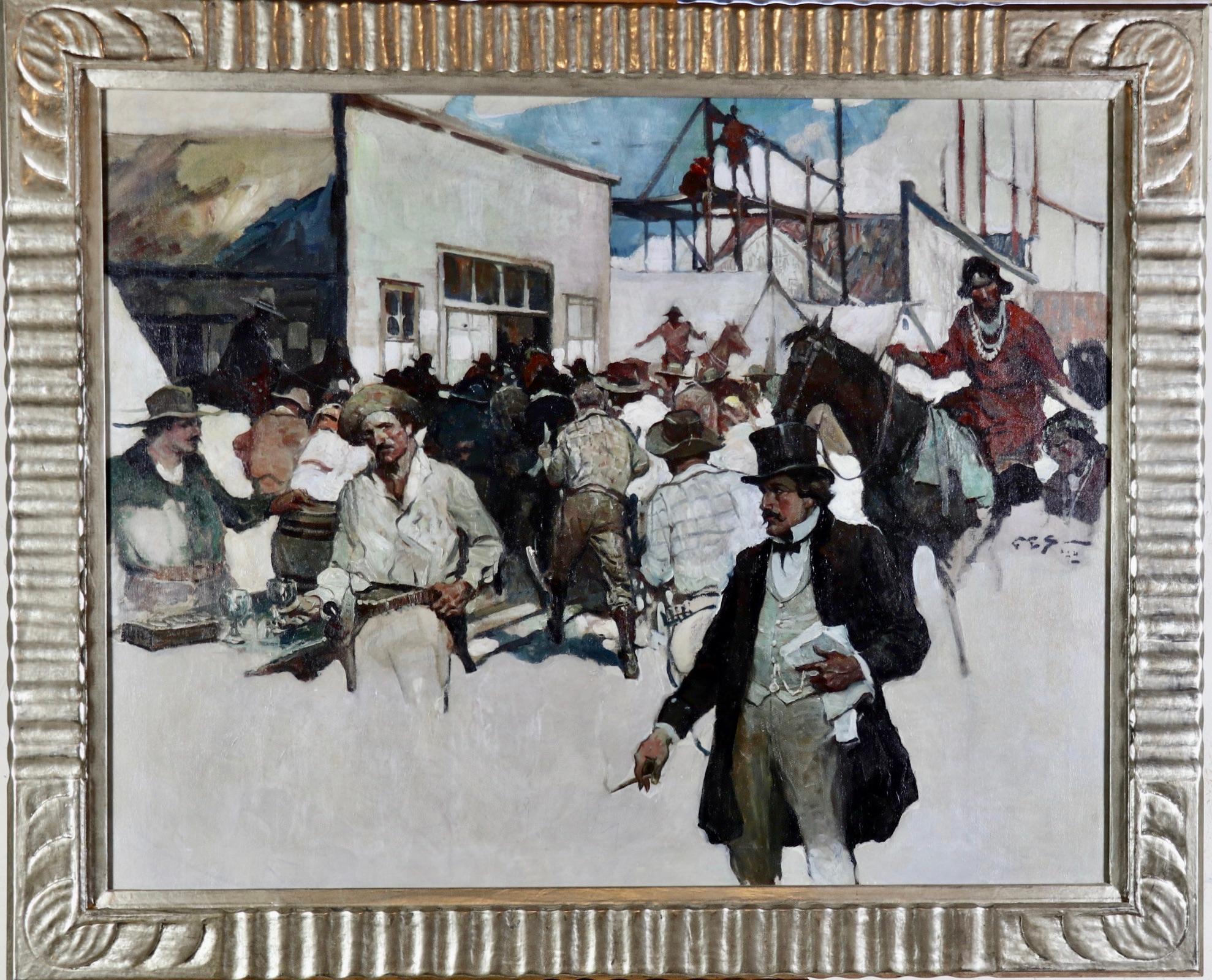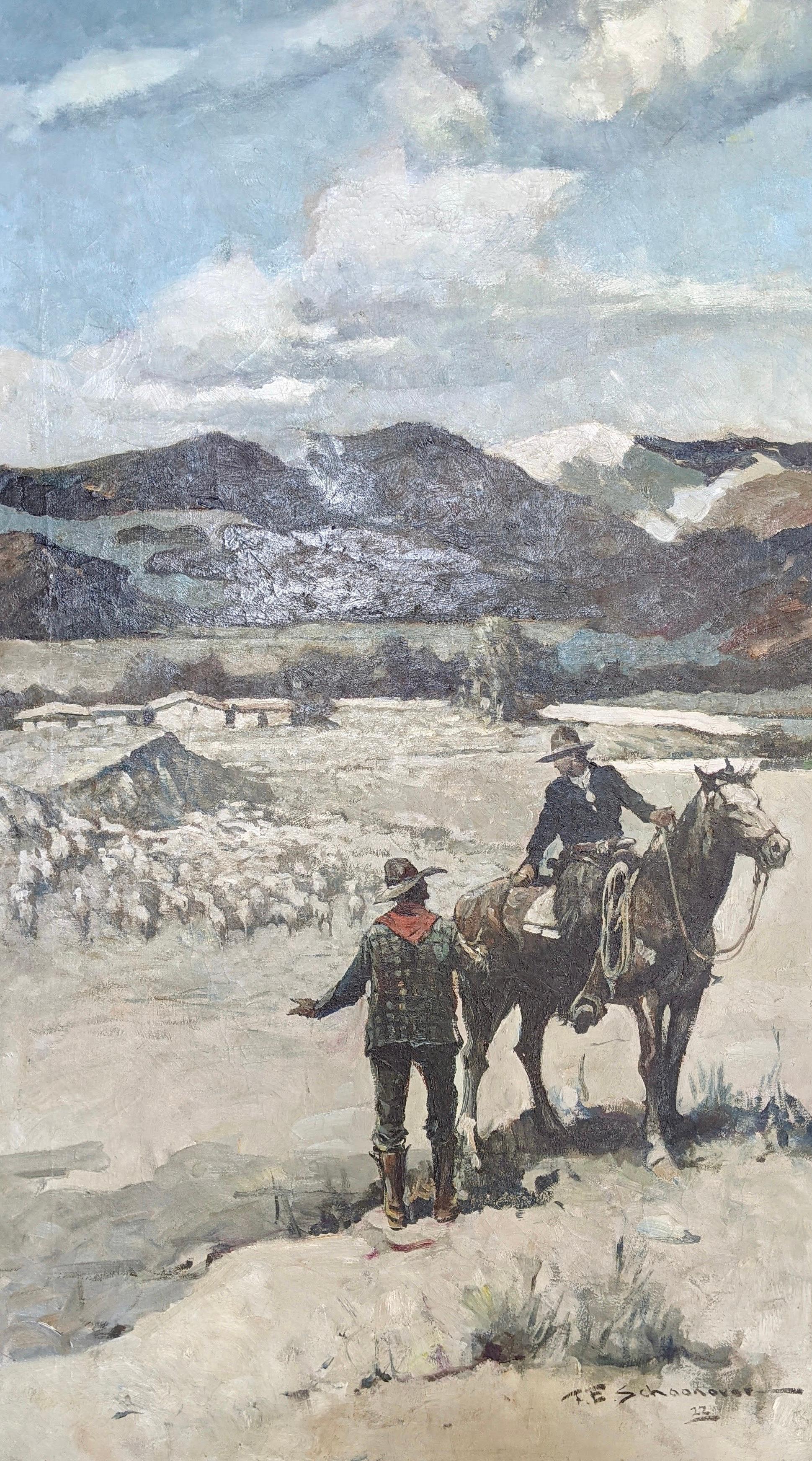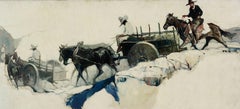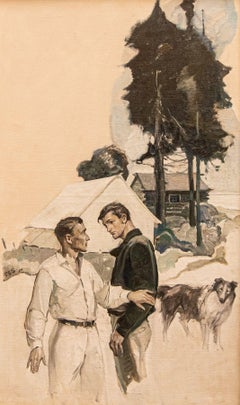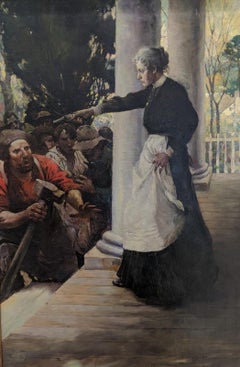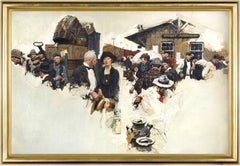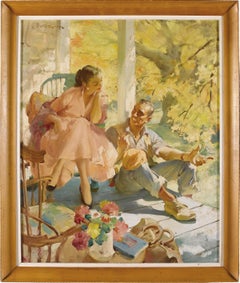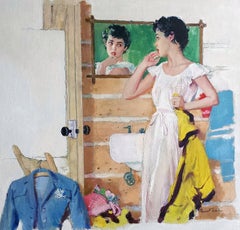Items Similar to I'm Going to be Married
Want more images or videos?
Request additional images or videos from the seller
1 of 5
Frank SchoonoverI'm Going to be Married1930
1930
$14,000
£10,565.42
€12,095.80
CA$19,744.64
A$21,677.15
CHF 11,309.02
MX$262,323.74
NOK 141,740.98
SEK 133,557.27
DKK 90,291.94
About the Item
Magazine story illustration for "After All I've Done" by William M. John for the Ladies' Home Journal, published September 1930, page 36.
This story, narrated by Uncle Asy Mulberry, a philosophical old man in Prohibition-era Tumbleweed Valley, Colorado, recounts the tale of Garnet Hamilton. Orphaned at age five, Garnet is taken in by Mrs. Sackett. Mrs. Sackett is a stern, self-righteous woman who constantly bemoans the burden of raising Garnet, overworking her and neglecting her education. Despite these hardships, Garnet blossoms into a beautiful and earnest young woman.
One summer, Garnet encounters Bob Montgomery, a "tall, rangy young fellow" from Texas. Bob earns Garnet's admiration when he intervenes after a drunken man insults her. Bob buys a local farm and develops a growing interest in Garnet. Their secret meetings, including a kiss at a church social, are discovered by Mrs. Sackett, who furiously threatens to banish Garnet if she ever sees Bob again. Later, Bob is wrongfully accused of a crime, but Garnet firmly believes in his innocence.
The illustrated scene depicts Uncle Asy encountering Garnet on the road. She's determined to elope with Bob, having left Mrs. Sackett's home. Uncle Asy offers her a ride to Bob's place. He describes Garnet as dressed in ill-fitting, old clothes and carrying a makeshift suitcase: "They'd been her mother's clothes, I reckon. She was carryin' an old telescope tied with binder twine." Frank Schoonover shows Garnet dressed in a long black skirt that drags on the ground, a green velvet jacket with large sleeves, and a small black hat adorned with a large red rose pinned on a wire at the front.
Signature: Signed Lower Right
Medium: Oil on Canvas laid to Board
- Creator:Frank Schoonover (1877 - 1972, American)
- Creation Year:1930
- Dimensions:Height: 24 in (60.96 cm)Width: 21.5 in (54.61 cm)
- Medium:
- Period:
- Condition:
- Gallery Location:Fort Washington, PA
- Reference Number:Seller: 36101stDibs: LU38435925902
About the Seller
5.0
Recognized Seller
These prestigious sellers are industry leaders and represent the highest echelon for item quality and design.
Platinum Seller
Premium sellers with a 4.7+ rating and 24-hour response times
Established in 1995
1stDibs seller since 2016
136 sales on 1stDibs
Typical response time: 1 hour
- ShippingRetrieving quote...Shipping from: Fort Washington, PA
- Return Policy
Authenticity Guarantee
In the unlikely event there’s an issue with an item’s authenticity, contact us within 1 year for a full refund. DetailsMoney-Back Guarantee
If your item is not as described, is damaged in transit, or does not arrive, contact us within 7 days for a full refund. Details24-Hour Cancellation
You have a 24-hour grace period in which to reconsider your purchase, with no questions asked.Vetted Professional Sellers
Our world-class sellers must adhere to strict standards for service and quality, maintaining the integrity of our listings.Price-Match Guarantee
If you find that a seller listed the same item for a lower price elsewhere, we’ll match it.Trusted Global Delivery
Our best-in-class carrier network provides specialized shipping options worldwide, including custom delivery.More From This Seller
View All"He Had Found His Quarry–Now the Question Was–What To Do" Western Illustration
By Frank Schoonover
Located in Fort Washington, PA
“The Gun-Runners” by Edwin Cole, published in The Youth’s Companion, May 6, 1926, pg. 343. Western illustration
Literature: Schoonover, Smith & Dean 1450
Artwork Dimensions: 17.5...
Category
1920s Figurative Paintings
Materials
Canvas, Oil
Hide Rack
By Frank Schoonover
Located in Fort Washington, PA
Medium: Oil Painting
Signature: Signed Lower Left
Hide Rack
Category
1930s Figurative Paintings
Materials
Oil
"We Went Into Camp"
By Frank Schoonover
Located in Fort Washington, PA
Medium: Oil on Canvas
Signature: Signed Lower Right
Category
Mid-20th Century Figurative Paintings
Materials
Canvas, Oil
""I Had Tried Several Times to Meet Dawn Woman" Story Illustration
By Frank Schoonover
Located in Fort Washington, PA
Story illustration for "Beaver Woman's Vision" by James Willard Schultz, published in The American Boy, July 1935, pg. 5 The White Buffalo Robe, Schutz, pg. 30
Literature:
Schoono...
Category
1930s Figurative Paintings
Materials
Canvas, Oil
No Longer Was Guthrie a City of Tents
By Frank Schoonover
Located in Fort Washington, PA
Initialed and dated 'FES/26' center right
Literature:
Courtney Ryley Cooper, “Oklahoma” in Country Gentleman, May 1928: 28.
Louise Schoonover Smith, LeeAnn Dean, John R. Schoonover...
Category
20th Century Paintings
Materials
Oil
The Sheepman Eyed Him With a Hostile Glare
By Frank Schoonover
Located in Fort Washington, PA
Signed & Dated Lower Right by Artist
Hendryx, James B. “The Round Seven Mystery.”
The American Boy, September 1922: 9.
caption: The sheepman eyed him with a hostile glare. ‘Why didn’t you ride right through ’em?’ he asked.
Hendryx, James B. Connie Morgan in the Cattle Country. New York: G.P. Putnam’s Sons, 1923: 96.
caption: The sheepman eyed him with a hostile glare. “Why didn’t you ride right through ’em?” he asked
Exhibitions: 1925 Washington; 1935 FAO Schwartz
Category
1920s Paintings
Materials
Oil
You May Also Like
A Daughter of the South
By Frank Schoonover
Located in Greenville, DE
Number 382 in the Schoonover raisonné. Signed and dated 1909. Beautifully reframed in custom 23 karat gold leaf frame.
Category
Early 1900s Realist Figurative Paintings
Materials
Canvas, Oil
Kindred of the Dust, Frontier Town Cosmopolitan Magazine
By Dean Cornwell
Located in Miami, FL
A somewhat similar Cornwell featuring a strong woman at the center of a the composition just sold at Christie's for $164,000. In this work we also see a strong woman at the center of the composition. Here she surrounded by men.
More than 20 beautifully rendered post-impressionist portraits in character, define Dean Cornwell as one of America's great artists. In his time, he was a famous as Norman Rockwell and was Norman Rockwell's favorite illustrator. "One thing puzzled Dirty Dan extremely. That was the perfectly frank, friendly manner in which his employer and this outcast woman greeted each other, the earnestness with which they conversed, and the effect of the woman's low-spoken words upon the color of Hector McKaye's face."
Morris Weiss collection...
Category
1920s Post-Impressionist Figurative Paintings
Materials
Oil
End of the Road, Golden Light Ladies Home Journal, Golden Age of Illustration
By Haddon Hubbard Sundblom
Located in Miami, FL
This painting is as much about the artist's brilliant painting skills and technique as it is about the subject matter. Sundblom's quick bravura brush strokes seem abstract on close i...
Category
1950s Post-Impressionist Figurative Paintings
Materials
Oil
Champagne for the Honeymoon
By Pruett Alexander Carter
Located in Miami, FL
Pruett Carter captures the quintessential look of the 1950's in this loosely rendered but charming work for Redbook. Bright, punchy colors define each object and are arranged in a simplified but complex composition of intersecting and overlapping planes of color.
The double portrait of the girl expresses a peak moment of introspection. She ponders her situation while preparing to get dressed for her special occasion. The whole scene is imbued with suspense about her future. Carter is a great academic painter. With just a few light touches of the brush, he quickly defines the form of the subject and achieves the X factor of the work. The profile and frontal view of the girl clearly are the same person. He nails her look. This is hard to do. Do not underestimate it. Sadly, there is a reason why there are very few contemporary artists can actually paint and draw without tracing photographs or resort to naive painting. It's hard to do. It's hard to be a painter. You can not fake...
Category
1950s American Realist Figurative Paintings
Materials
Oil
$18,500 Sale Price
22% Off
Oil on Canvas Portrait Painting of a "Fashionable Young Lady" by Irving Wiles
Located in New York, NY
Irving Ramsay Wiles, 1861-1948
A Fashionable Young Lady
Oil on canvas
28 1/8 x 22 5/8 inches
Signed lower right: Irving R Wiles
Illustrator, teacher, and painter Irving Ramsey Wiles was adept at portraits, figural works, and
landscapes characterized by the informal elegance of cosmopolitan American art at the turn of the twentieth century. Wiles received his earliest art instruction from his father, landscape painter and teacher Lemuel M. Wiles (1826–1905), and at the age of eighteen, in 1879, exhibited his first painting at New York’s prestigious National Academy of Design. After one year’s study at the Art Students League in New York, under the influential painter-teachers William Merritt Chase and J. Carroll Beckwith, Wiles went to Paris for further study. He enrolled in the Académie Julian, a popular school among American artists, and then worked in the studio of French academic painter Charles Auguste Émile Durand, known as Carolus-Duran (1837–1917). During his student years Wiles painted watercolor street scenes of Paris, and he also traveled in Italy and in the French countryside.
Wiles returned to New York in 1884 and exhibited two of his sketches. These attracted the notice of the art editor of the popular Century Magazine, who asked the young artist to make illustrations for the journal. Wiles’s illustrations appeared in other publications as well, and he also supported himself by teaching at his studio and at his father’s summer art school in upstate New York. Wiles was elected a member of the progressive Society of American Artists and, after one of his works won a prize there, to the National Academy of Design as an associate member; full membership followed in 1897. By that date, Wiles was able to devote himself more fully to portraits and figural compositions in oils, paintings that mark the influence of his teacher Chase, who remained a lifelong friend. Like his mentor, Wiles also worked in watercolor and pastel and belonged to several organizations devoted to those media, which enjoyed revivals in late-nineteenth-century America. He exhibited his work widely and won numerous awards throughout his career.
In the late 1890s, Wiles and his father moved their summer classes to Peconic, on the North Fork of New York’s Long Island...
Category
1890s Portrait Paintings
Materials
Canvas, Oil
THE BRIDGE
By Frank Benson
Located in Portland, ME
Benson, Frank. THE BRIDGE. Paff 227. Drypoint on copper, 1923. A trial proof of the second state, printed on uncalendared Japanese Vellum, annotated "B-1," the first of two trial pro...
Category
20th Century American Realist Figurative Prints
Materials
Drypoint
More Ways To Browse
Black Velvet Paintings Of Churches
Darwin Estacio Martinez
David Dear
David Popiashvili
David Van Der Linden
Didier Lapene
Elizabeth Cat
Evariste Carpentier
Fabian Acrylic
Fantuzzi Eliano
Feroz Khan
Flora And Zephyr
Francesco Minuti
Frans Francken The Younger
George Underwood
Gil Elvgren Vintage Pin Up Girl
Girl Reading Book Vintage
Guy Boudro
